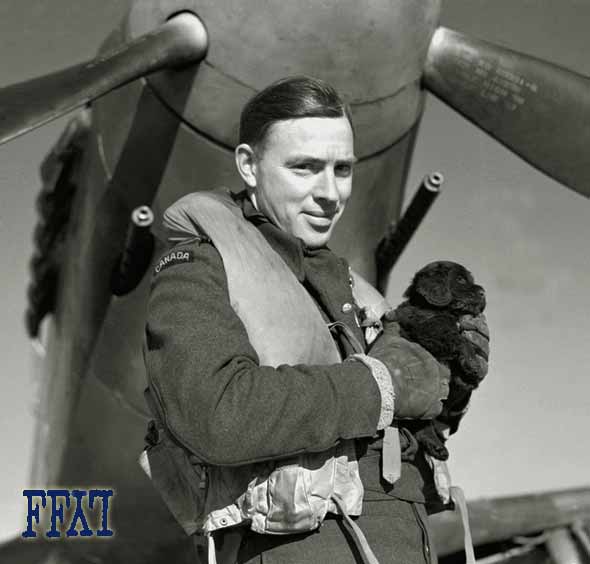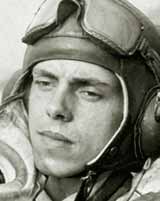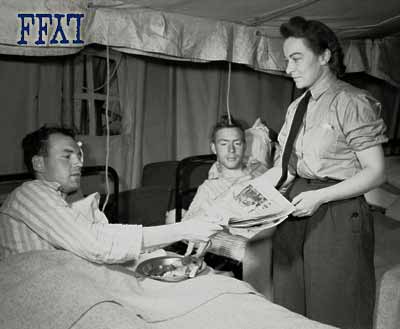Charles Herbert "Smokey" StoverRCAF S/L - DFC
|
|||||||||||||||||||||||||||||||||||
-------------------------------------------------- TILT WITH NAZI DISGUSTS YOUNG CANADIAN PILOT
|
|||||||||||||||||||||||||||||||||||
LUCK SAID DIVIDEDWith the R.C.A.F. Somewhere in England, Aug. 21, 1942 — (CP Cable) — Cliff Horncastle and Charlie Stover do thing in pairs in their Canadian Army Co-operation squadron, but they were of different minds today as they told of the part they played in the battle of Dieppe. |
|
And they were all in good spirits, for F/L Freddy Clarke, of Calgary, the only Canadian troop pilot who didn't come home on schedule, had just wobbled in from a hospital with little more than a sore head and a black eye to show for a crash landing in the sea.
Word went round to keep away from Horncastle, who was described as temporarily a bad man to know — "definitely a dangerous character." A scrap with a Focke-Wulf-190 that was first a cinch, then a flop, was to blame.
Horncastle didn't look dangerous as he sat at the table, dangled his leg over the side and grinned at a group of officers standing around him, all of whom apparently had been giving him quite a ride.
"I guess I was pretty sore for a while." Cliff explained. "But I'm feeling better now. After all, Holly (F/O Hollis Hills, of Los Angeles) got a Jerry. But boy, it would have been nice to make it two."
Horncastle and Stover were flying together on one of the dawn-to-dusk flights members of this squadron made. They went out about 8 a.m. and were 25 miles inside France when, said Cliff, a FW-190 "jumped on us."
"He turned on me when he saw me coming," Cliff went on. "But somehow or other I got on his tail. I chased him for about five minutes and if it hadn't been for the guns it would have been a set up.
Couldn’t Fire
But as luck would have it, only one of the guns of Horncastle's Mustang would fire.
"Boy, oh boy, Cliff concluded sorrowfully. I sure am a disappointed guy."
Not Stover, however. About the time Horncastle was chasing his FW-190, four more of these newest Nazi fighters "jumped" at his partner from above.
Horncastle saw them coming and shouted "quick, get out of it," over the intercommunications phone to Charlie. Stover got out of it, diving to "naught" feet in the most evasive action of his life.
He eluded the FW-190 all right, but did not notice a cement telephone pole coming up at him from the ground.
"There was a crash," he said. "The next thing I knew I'd left four feet of wing behind me. I sure wasted no time getting out of that place."
These two experiences taken at random from scores of stories of pilots told on their return are typical of the job the army co-ops did in the course of their reconnaissance patrols.

Smokey shows off what's left of his wing
--------------------------------------------------
Born in Sarnia, Ontario, 8 September 1915. Award presented 28 May 1947. Shell sales manager after the war. Passed away in Nov. 2002 at 87 years of age |
--------------------------------------------------
A Short Bio Written by Smokey's son Ron
My father's hometown was Sombra near Sarnia, Ontario and eventually, the 414 Squadron was adopted by the City of Sarnia. Sarnia was the home of Imperial Oil Co ( ESSO) and the name City of Sarnia Imperials came from that connection. My father joined the RCAF in early 1941 and entered flight school on July 1 , 1941. He was a second year mechanical engineering student at Queen's University in Kingston Ontario.
He received his wings on November 21 , 1941, arrived in England in January 1942 and was posted to Squadron 414 on March 3, 1942 as a Pilot Officer. At that time 414 was flying Tomahawks. The first familiarization flight in a Mustang was on June 14, 1942 at which time the Squadron was changing to Mustangs. His first mission was Dieppe and the task seemed to be survival as noted by the pictures.
December 1942, he was promoted to F/O . On November 5, 1943 S/L Peters, was listed as missing on a mission and my father was appointed as Squadron Leader for 414. The Squadron was very active in the time period from January to June flying missions into France to photograph various enemy positions and airfields in preparation for D-Day. This was a key part of the D-Day preparation. May 19, 1944, he received the DFC. June 6, 1944, the squadron was responsible for directing naval bombardment. Dad was directing the fire of the 15" guns of the U.S.S. NEVADA . His logbook reads on June 6, 1944
"Did shoot with U.S.S. Nevada. Unable to contact second ship so did a cooks tour of Allied landings - Very thrilling sight."
The following two weeks was spent doing a lot of reconnaissance in the Caen area. In excess of 25 hours flight time from June 6. On the 23rd June, he and F/L Norm Rettie were jumped by 7-8 FW190's east of Caen. F/L Rettie (currently lives in British Columbia) was shot up but landed safely at a forward air base. My father was not as lucky and had to bail out. His logbook entry reads :
" F/L Rettie as #2- bounced by 7-8 FW190's East of Caen - Norm was shot up - landed safely - I was shot down, bailing out at Birville at approx 500-750' landing 500 feet inside British lines injuring back. Air evacuated from France to England."
The aircraft was recovered in an archeological dig near Caens in 2003, 6 months after my Dad passed on.My father remained in the Air force until May 1945 and joined Shell Oil until his retirement in 1977. He continued to fly in the RCAF reserve, Mustang P51-D's and Harvards until 1956. He was the Aviation Fuel Sales and continued to fly aircraft in his business career.
In 2000, he was appointed as Honorary Lt. Colonel of Squadron 414 which was based in Comox B.C. The Squadron has since been disbanded in 2002.
Stover, recovering at a mobile field hospital in France before being evacuated to England, looks on as "Milly" Millman of manitoulin Island offers F/L Rettie some reading material
--------------------------------------------------
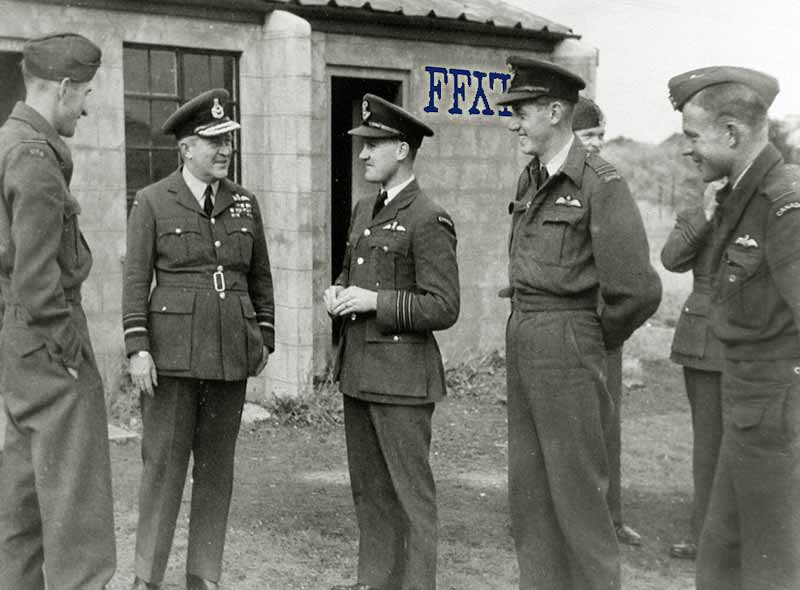
Holly Hills, Billy Bishop, Roy Begg, Knobby Clarke (Frank Greenwood & ?? behind) & Smokey
R.C.A.F. CO-OPERATION WING BEING PREPARED FOR ACTION
Original Squadron Develops Into Important Part of Overseas Set-up
"EYES OF TROOPS"
Ottawa, Feb. 8, 1943 — (CP) — Formation of the first RCAF army co-operation wing was announced by air force headquarters today. It is under command of Group Capt. Douglas M. Smith, of New Westminster, B.C., a member of the R.C.A.F. since 1934 and formerly officer commanding one of the squadrons of the wing.
Now Forms Wing
An army co-operation squadron was one of the first units the R.C.A.F. sent to Britain. Now the original squadron has grown into three, forming a wing.
The new wing soon will be ready for action as a unit, said the headquarters statement. When the Canadian Army goes into action, Mustangs of the army co-op wing will be flying overhead, acting as eyes of the troops. Two of its squadrons took part in the Battle of Dieppe last August.
The wing is based at a huge aerodrome in Britain recently completed in record time by the Royal Canadian Engineers and handed over to the R.C.A.F. by Lt.-Gen. A. G. L. McNaughton, commander of the Canadian Army overseas.
The pilots fly Mustangs, which combine high speed, extreme maneuverability and heavy armament.
Different Set-Up
The squadron formerly commanded by Group Capt. Smith now is commanded by Wing Cmdr. Roy F. Begg, of Vancouver. The other squadron commanders are Wing Cmdr. R. C. A. Waddell, of Peterborough, Ont, and Wing Cmdr. Ernie Moncrieff, A.F.C., of Winnipeg.
Formation of an army co-op squadron differs from that of bombers, coastal and fighter units, the announcement said. The establishment includes a second-in-command, a squadron leader, a flight lieutenant in charge of operations and flight lieutenants as flight commanders. To maintain the necessary close contact with the army, the commanding officer makes his headquarters with the army when action is scheduled.
Pilots of an army co-op squadron must be half airmen, half soldiers, and are all expert map-readers. Each pilot spends a month with various army units, such as infantry, tanks and armored cars, to better understand the work of the men on the ground.
Scouted at Dieppe
Attached to such squadrons are army liaison officers, who perform the duties usually done by air force intelligence officers with other units, including briefing of pilots before an operation and interrogation when the pilots return. Most of the officers with this wing are members of the Royal Canadian Artillery.
The most exciting experience of the army co-op pilots lo date was the Dieppe raid, when their job was to scout all roads past Dieppe and report troop movements. They saw little movement on the ground, but ran into plenty of action in the air.
The sky over the actual battle area was thickly covered by an umbrella of fighter planes, but outside that area Nazi planes were waiting to pounce.
Plenty of Excitement
One of the squadrons, that commanded by Wing-Cmdr. Begg, had more than its share of excitement. F/L Fred Clarke, of Calgary and the Barbados, was attacked by a Focke-Wulf 190 and shot down into the sea. His pal, P/O Holly Hills, an American now a member of the United States Navy, attacked the Focke-Wulf and shot it down in flames, the squadron's first and only victim to date, Clarke later was picked up by a naval craft unhurt.
F/O Charles (Smokey) Stover, of Sarnia, Ont., was flying at about 50 feet when forced to take evasive action from a Focke-Wulf 190. He dived down too low and his wing hit a telephone pole. Although three feet of his wing tip was sliced off and half his aileron gone, Stover brought his machine safely back to base.
Since then Stover has been married to the daughter of a former pilot of British Imperial Airways.
S/L Frank Greenwood, of Beloeil, Que., second-in-command of his squadron, who also has been married since he left Canada, recently became a father. He holds the record of having landed the first aircraft on the present station, setting down a Tiger Moth-when the runways were only partly completed.
--------------------------------------------------
SPEEDY DEATH GIVEN GERMANS BY OUR PILOTS
An R.C.A.F. Fighter Base, Somewhere in England, Jan. 28, 1944 - (CP) - Four members of the R.C.A.F. Mustang Squadron commanded by S/L C. H. (Smokey) Stover of Sarnia, today destroyed four enemy planes over the old French Cathedral City of Charters, 45 miles southwest of Paris with such speed and thoroughness that the Nazis didn't fire a single shot in reply.
This bag brought to 11 the number of German planes destroyed by Canadian airmen in two daylight sweeps. A Mosquito squadron led by W/C Don Macdonald of Vancouver shot down seven on Thursday.
Today's kills were shared by F/Ls. Gordon Wonnacott, Edmonton; George W. Burroughs, 92 Bowie Ave., Toronto; J. T. Seamen, Lewisville, N.B., and F/O R. O. Brown of Daysland, Alta.
Came On in Pairs
The Canadians came on the Germans in pairs. Brown, a former intercollegiate light-heavyweight boxing champion when at McGill University, got the first, and the other three Canadians had a hand in destroying the second plane, raking it with machine-gun and cannon fire.
"No sooner had we knocked down the first two," Burroughs said, "than two Messerschmitt 109’s appeared. It all happened so quickly that it is pretty hard to reconstruct, but I know I shot down the first of this pair and seconds later could see Wonnacott's victim heading for the dirt."
This "show" lasted less than four minutes.
It was the first time the squadron had found any Germans within firing range since early in December when it bagged four in two days.
Use Strange Mixture
Wonnacott said when the Canadians finally caught up with the Germans today they didn't seem anxious to fight, but wanted to get away in a hurry "and we had to turn on a bit of juice to catch them."
The Mosquito success Thursday is believed to have tripped a projected nuisance raid on Britain. The Canadians destroyed a Focke-Wulf 200, a four-engined bomber; a Heinkel 177, also a four-engined plane; a Heinkel 111 bomber and four Junkers bombers. Because of the type of planes knocked down it seemed the Nazis were preparing another large-scale raid. In last Friday's attack on London the Germans are known to have used an extraordinary mixture of aircraft.
--------------------------------------------------
R.C.A.F. CARRIES HEAVY BOMB LOADS TO HUN
Ottawa, Feb. 4, 1944 - (CP) - R.C.A.F. bombers participating in the three hammer-blow raids on Berlin during the past week carried a bomb weight far heavier than the whole German Air Force ever dropped on Britain in a single night, the R.C.A.F. reported today in its weekly summary of overseas operations.
On the first of the three raids, F/S S. H. Campbell of Drumheller, Alta., rear gunner in the "Goose" bomber squadron, shot down a rocket-firing Messerschmitt 110 night fighter.
"We were just on the rim of the target area when the fighter started to attack us," said Campbell. "He was 440 yards away and silhouetted against the red glow of the flames below coming through the clouds. I told the skipper to bank to starboard and as the fighter followed us on the curve of pursuit, I gave him a long burst, scoring a hit on the starboard rocket.
"The enemy nightfighter broke off the combat, but attacked again coming up underneath and, as Campbell fired again, he saw it flip over on its back in flames and a few seconds later explode on the ground below.
An R.C.A.F. Mosquito squadron "went to town" one day of the week when four of its pilots knocked down seven enemy aircraft within eight minutes.
W/C D. C. S. Macdonald of Vancouver, commanding officer of the squadron, accounted for a Heinkel 111 and a Heinkel 177 and F/L C. Scherf, an Australian pilot in the squadron whose navigator is F/O L. Brown of Winnipeg got a Focke-Wulf 200. F/L J. Johnson of Omemee, and F/O J. Caine of Edmonton reported four Junkers destroyed.
Mustangs Score Again
After six weeks of silence the R.C.A.F. Mustang squadron under S/L C. H. (Smokey) Stover of Sarnia, also bounced back into the news by shooting down four enemy aircraft in one day. The kills were shared by F/L J. T. Seaman, Lewisville, N.B., and F/O R. O. Brown of Daysland, Alta.; F/L Gordon Wonnacott of South Edmonton and F/L George Burroughs of Toronto.
Their first two victims were unidentified, but the second pair, bagged by Burroughs and Wonnacott were Messerschmitt 109's. One of the unidentified aircraft "just blew up in mid-air," said Burroughs, the successful pilot. Meanwhile, the other three Canadian pilots attacked a second Nazi aircraft and aided in its destruction
In Coastal Command a heavily-armed minesweeper was sunk off the Norwegian coast by R.C.A.F. Beaufighters led by W/C C. A. Willis of Vancouver. A medium-sized merchant ship was also left on fire and an escort vessel raked with cannon fire. The Canadians saw the minesweeper blow up after their attack.
From Italy came the news that the mounting score of the City of Windsor Spitfire Squadron went up another notch when it destroyed a Focke-Wulf and damaged another while protecting British invasion craft off the Nettuno beachhead.
The City of Windsor unit has bagged more Huns than any other squadron in the desert air force over the beachhead. In seven days, since the landing began, it has destroyed four enemy machines with two more probably destroyed and four damaged. It has lost one pilot, although some have made several forced landings.
--------------------------------------------------
Four Canadians Are Decorated
Ottawa, May 20, 1944 - The effective destruction of enemy planes, locomotives and shipping is .reflected in the award of the Distinguished Flying Cross to four members of the R.C.A.F. serving overseas, air force headquarters announced last night. Those decorated are Squadron Leader C. H. Stover, of Sarnia, Ont.; Flight Lieutenant G. W. Burroughs, of Winnipeg; Flight Lieutenant G. A. Muir, of Winnipeg and Flight Lieutenant R. G. Middlemiss, of Montreal. Stover has participated in operations for almost two years, having made his first sortie during the attack on Dieppe. Burroughs also has taken part in a large number of reconnaissance and ranger sorties, having participated in 28 coastal patrols. Muir is a veteran of night intruder operations over Rhodes, Cos and Crete, and Middlemiss has completed two tours of operational duty which involved sorties from both Malta and the United Kingdom. |
 S/L Stover |
--------------------------------------------------
STOVER, S/L Charles Herbert (J8922) - Distinguished Flying Cross - No.414 Sq.
Award effective 12 May 1944 as per London Gazette dated 19 May 1944 and
AFRO 1380/44 dated 30 May 1944.
Squadron Leader Stover has been engaged on operations since August 1942. He has completed a large number of flights with outstanding courage and resolution, the first of his sorties being during the Dieppe operation. In August 1943, he led a mission to the Paris area where he destroyed a Junkers 88 and damaged enemy locomotives and a tug. During another operation in November 1943, he shared in the destruction of a Junkers 52. Many of the sorties completed by this officer have involved deep penetrations into enemy territory, while others have been on reconnaissance and photographic duties.
NOTE: Public Record Office Air 2/9626 has recommendation drafted about 20 March 1944 when he had flown 55 sorties (79 operational hours).
Since August 1942, this officer has carried out a large number of operational sorties with great courage and determination. His first operational flight was during the Dieppe operation. On August 21st, 1943, he led a Ranger sortie into the Paris area and personally destroyed a Junkers 88 and shared in damaging one tug and four locomotives. On November 5th while leading another Ranger he shared in the destruction of a Junkers 52 on Beauvais Lille.
This officer has taken part in twelve successful Rhubarbs and Rangers, seven of which have involved deep penetrations into enemy territory as well as one night Intruder patrol. In addition he has carried out six shipping reconnaissance, 17 Tactical/Reconnaissance and photographic reconnaissances and a large number of anti-Rhubarb patrols. At all times Squadron Leader Stover has shown outstanding skill and devotion to duty on operations and by so doing has provided a great inspiration to those under him.
On 21 March 1944, Group Captain E.H. Moncrieff added his remarks:
This officer has proved himself to be a most competent and outstanding Squadron Commander, displaying at all times the greatest determination in the execution of his duties, and his outstanding skill as a reconnaissance pilot and unswerving devotion to duty are an example to all those who serve under his command.
On 23 March 1944 an A/V/M Dickson noted:
I recommend this award. For over 20 months this officer has been serving in reconnaissance squadrons engaged in sporadic operations. While there are no highlights to record in his citation the work of reconnaissance pilots, although not spectacular, calls for high morale and determination. These qualities have been outstandingly evident in Squadron Leader Stover and the award if made will do much to encourage the pilots of the squadrons.
This was duty supported by Air Marshal Coningham (9 April 1944) and by Air Chief Marshal Leigh-Mallory (23 April 1944).
--------------------------------------------------
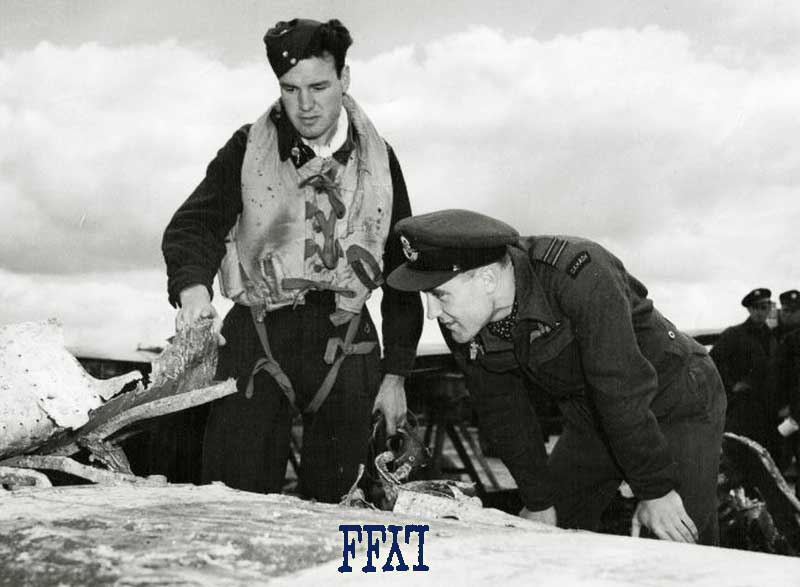
Norm Rettie & Dave "Ludwig" Bernhardt inspect battle damage
'RECCE' PILOTS CALLED NAVY WRATH ON NAZIS
by GREGORY CLARK, Star Staff Correspondent - At a Canadian Airfield in England, June 7, 1944 —The Canadians made their sensational landing in Normandy under not an umbrella but a roof of fighter, intruder and bomber aircraft. A roof of woven lightning according to S/L C. H. "Smokey" Stover, D.F.C., leader of the City of Sarnia squadron.
''At times it made your hair Bland on end,"' said this leader of one of our most daring reconnaissance Mustang squadrons, ''to see the melee of planes of every description over the bridgehead.
Dodging Whole Squadron
"To be working alone on a recce job and find yourself the object of menacing interest to a whole squadron of Thunderbolts, then to turn away and find yourself sailing headlong at a full squadron of Lightnings is enough to keep your mind off your work. I personally have never seen and have never imagined such a scene of concentrated air action. It was a roof not an umbrella. It prevailed all the way from Cherbourg to Le Havre, and I imagine the Canadians on the ground, making their record-breaking dash for Caen, will have been as impressed by it as we were in the air."
The City of Sarnia squadron had a choice job for seeing the landing as a whole. They were elected to serve as reconnaissance spotters for the navy and did two flights, one immediately after the other, coming home to the nearest point of England to refuel at half-time.
Their first flight took them in just at daybreak. Each of their planes was in touch by a special wireless band with a certain battleship or cruiser in the coastal bombardment. On arriving over the beach, as the landing barges drew nigh, the pilots called up their ship and immediately the ship opened with sighting shots on the prearranged target, most of them German shore batteries and rocket mountings. Nearly all these targets had been destroyed by the bombing of the night before, and as F/O Jack Donovan of Toronto says: “All I found when I got over my first area was a large mud hole.”
After pasting these first targets and coming home to a temporary refueling point in England, the Sarnia Squadron pilots raced right back into the fight with a free hand to locate targets inland for the battleships.
Flying Officer Lew May of Toronto, accompanied by F/O Jack Roussell of Montreal on this flight, spotted a battery of German field guns in the first morning light, shooting furiously at the beach on which the Canadians were landing. Got Some Action |
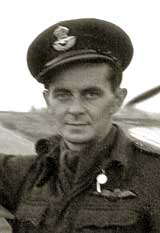 Lew May |
All these recce jobs were being done amid what their squadron leader "Smokey" Stover called a melee of hundreds of fighter and bomber planes, including the dreaded Typhoon with its rockets and the equally dreaded Thunderbolt and Lightning, raging about looking for blood and finding next to none. In fact, at the end of the day our squadrons on this airfield had to confess they had not seen a single enemy plane they could certainly identify.
Big Guns Silenced Foe
The most stupendous experience of the day fell to F/O Ken Brown of Montreal, with whom was F/L P. W. Brunelle, of Outremont. The ship they were serving was a monster battleship with 14-inch guns and their first two targets, which were coast defence artillery, fell silent after half and hour cooperation between the little bugs aloft and the bulging monster a few miles to sea.
Their next targets were a parcel of field guns firing at the beaches, which the battleship decided not to Prang for fear our infantrymen were already nearing them, so the field guns were handed over via the wireless to some Typhoons looking for meat. The ship asked Brown to go on the hunt and find them something to shoot at.
Brown and Brunelle wove their way at low altitude up and down the roads and low over the wood-lots of Normandy but could find nothing. The two were calling each other and talking over their intercom when the battleship interrupted and inquired, "What is all the chattering about? Get us something to shoot at.”
Eight Shells Finish Job
At that moment they hoicked up over a hill and from a field surrounded by trees anti-aircraft guns blazed at the two Mustangs. With the trained eye of the Recce pilot, Brown and Brunelle climbed and circled and studied the open field. Four bofors guns were there dug into pits. So they gave their battleship these for a target. The first ranging shell from that ship miles away hit the field. In all, eight 14-inch shells whacked into that field and the enclosing woods and Brown is quite sure those four guns will no more disturb innocent aircraft flying over, nor do anything to hinder the Canadians coming fast from seaward.
At sea, on the ground, in the air, D-Day was a Damn great day for Canadians in all directions.
--------------------------------------------------
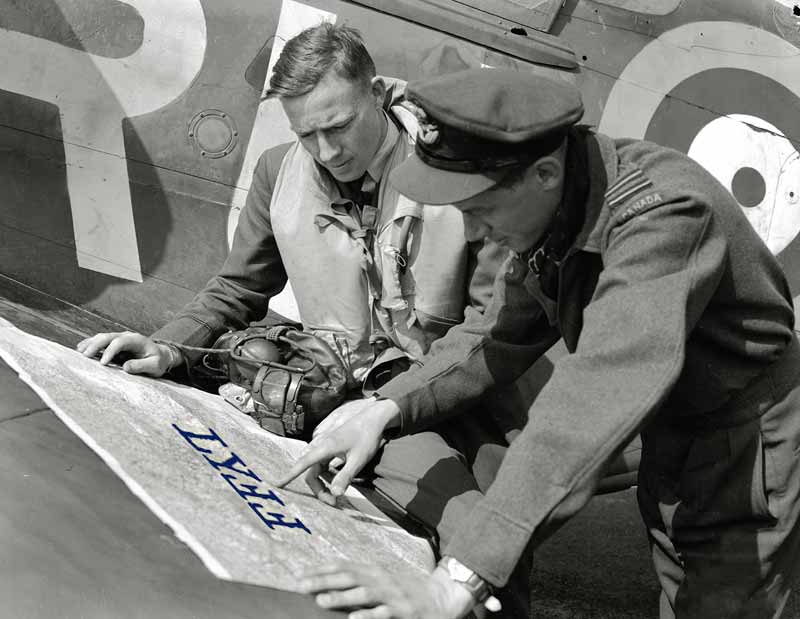
Charles "Smokey" Stover & Fred "Knobby" Clarke going over the details
Fliers Skim Trees, Duck Flak To Spot Enemy Moves in France
With the R.C.A.F. Overseas, June 21, 1944 - (CP) - A mosaic of Hitler's European defenses and the destruction wrought by Allied bombing has been mapped by the Canadian reconnaissance wing of the 2nd Tactical Air Force, commanded by G/C E. H. G. Moncrieff, A.F.C., of Winnipeg.
Now the wing is keeping tab on Nazi troop and other movements to guide later Allied offensives. Operating from a British airfield commanded by W/C J. M. Godfrey, 52 Nina Ave., Toronto, the "RECCE" pilots have gone out daily to take aerial photographs of occupied territory or to spot enemy movements from the air, the R.C.A.F. said in a press release tonight.
To get information the "RECCE" fliers have often flown at tree-top level over their target, disregarding flak or other opposition, and have had their share of combat in the air.
When time permitted they have conducted fighter sweeps with outstanding success. For two months in the summer of 1943 one "RECCE" squadron was the top scoring unit in the 2nd Tactical Air Force.
Commander of one squadron is S/L C. H. (Smokey) Stover, D.F.C., of Sarnia. W/C R. C. A. Waddell, D.F.C., of Peterborough, is wing commander (operations).
--------------------------------------------------
Victories Include :
21 Aug. 1943 |
one Ju88 1/2 Ju52 one FW190 |
destroyed destroyed damaged |
(w/ F/O K.A. Brown) |
1.5 / 0 / 1
Also reported to have attacked and damaged
eight locomotives, one pylon, one tug, one transformer station ... and lots of other stuff |
--------------------------------------------------


